Lucy Perkins Ripley, 1875 – 1949
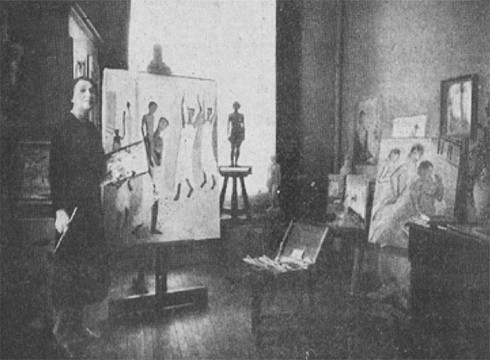
Born in Winona, Minnesota on November 5, 1875, Lucy Perkins married Paul Morton Ripley on November 30, 1913. University of Wisconsin alumnus (1904), he worked as an American transportation executive; they divorced on October 9, 1937.
Ceramicist, sculptor, and painter, Ripley was especially inspired by Ancient Greek, Assyrian, early Italian, Egyptian, Etruscan, Gothic, Native American, and Persian art. Like many artists of her time, Ripley studied for several years at the Art Students League of New York with sculptor Augustus Saint-Gaudens. His son, Homer, recalls that Lucy Perkins was a pupil of his father’s and that she “therefore, could speak with ready knowledge of his attitude while teaching” (xvi). At the time (c. 1903), Lucy was also associated with the Brush Guild (126 West 104th street, New York city), where she and her mother, Annie F. Perkins worked:
Their product, now known as “Perkins pottery,” is all in monochrome, either black or very deep brown, and is built up by hand without the aid of wheel or mold; the decorations, whether merely lines or sculpted figures, are carved out of the substance of the clay of which the pottery is made. The pottery is made on Etruscan lines, but the decoration, as a rule, is entirely original, and there are no duplicates (Bulletin of the Department of Labor, 1606).
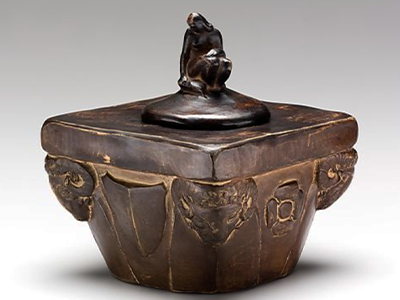
According to Frelinghuysen, et.al., the mother and daughter “kept the guild’s name alive when they exhibited in subsequent years, even though by then their work was essentially independent” (253). Lucy also taught a course in Chautauqua, New York, where students made pots from local clays based on Native American models (Hutchinson 107).
While Lucy initially created flower pots and other garden decorations in clay or cast in lead, she eventually turned to sculpture as her preferred medium:
From this humble beginning, progress came surely and naturally. Leaders in the art world soon saw that she was no mere potter, but a sculptor with decided originality and rare creative force. The individuality and fine expression of her simplest designs brought her serious recognition and gave her a place of distinction in that phase of art expression in which she was then employed (Merrick 15).
Though she became an accomplished sculptor, Lucy later “turned to the brush” (Devree X8) and exhibited her paintings, for which she also gained critical acclaim. The French government bought one of her works, “Paysage: Maisons,” which entered the collection of the Franco-American Museum of the château de Blérancourt in 1962 (image reference: 5A04788).
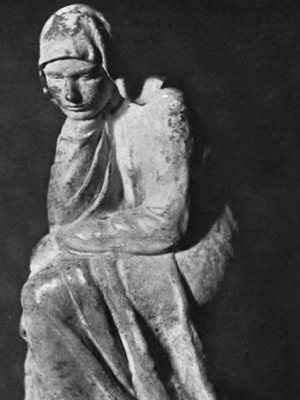
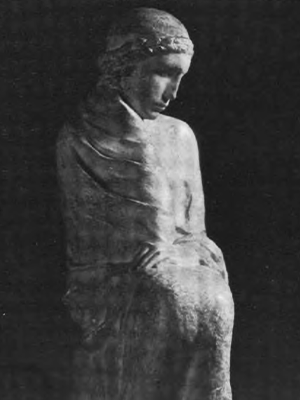
Ripley sailed to France around 1904, quickly establishing a long-standing connection to 4 rue de Chevreuse. She traveled extensively throughout Europe, especially France, Italy, and Spain. In Paris, she studied with sculptors Rodin, Despiau, and Lhote, and she was associated with the “Bande à Schnegg” (see, Jane Poupelet). In 1905, Ripley exhibited two small sculptures at the American Woman’s Art Association (AWAA) annual show. Janet Scudder also participated in the AWAA show and both artists were later featured in exhibitions in the U.S. In the 1920s and 1930s, after the Girls’ Art Club had been transformed into the American University Women’s Club, Ripley used one of the remaining art studios as her primary workspace.
Her first real success in Paris came by way of the sculpture, “Seated Woman,” which she had brought with her from New York. The work impressed Rodin, who recommended it for the Salon des Beaux Arts in 1919.
Back in New York in 1922, Ripley came to the attention of architect Stanford White who "[…] recommended her garden sculptures for the estates of Mrs. E. H. Harriman, Mrs. Charles Cary Rumsey, Mrs. Payne Whitney, Mr. Clarence Hay, Mrs. Arthur Curtis James and Mrs. Walter Bliss, who became her patrons." White purchased one of her well heads, conceived in Venice, for his country home at St. James, Long Island. (Merrick 17).
Her first real success in Paris came by way of the sculpture, “Seated Woman,” which she had brought with her from New York. The work impressed Rodin, who recommended it for the exhibition at the Société des Beaux Arts in 1919.
Back in New York in 1922, Ripley came to the attention of architect Stanford White who "[…] recommended her garden sculptures for the estates of Mrs. E. H. Harriman, Mrs. Charles Cary Rumsey, Mrs. Payne Whitney, Mr. Clarence Hay, Mrs. Arthur Curtis James and Mrs. Walter Bliss, who became her patrons." White purchased one of her well heads, conceived in Venice, for his country home at St. James, Long Island. (Merrick, 17).
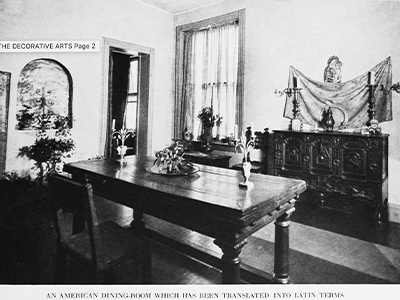
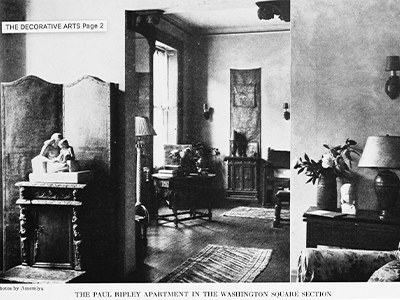
Her New York apartment at 12 Tenth street was profiled in a lengthy article in Town & Country (1926) that describes the furniture and objects Ripley had collected during her travels to Italy and Spain. The apartment also featured several of her garden decorations in wrought iron, a new, rather expensive medium at the time (1927, 55).
Sources make passing mention of her regular travels between the U.S. and France, rarely specifying where she actually stayed. However, two small articles in the New York Herald Tribune (European edition) provide insight as to her whereabouts:
- Lucy Perkins Ripley who passed the winter at Monte Carlo, has arrived in Paris and is at the St. James et d’Albany until she sails for America the middle of May. She will pass the summer at her home in Westbury and will return to Paris in the fall (April 16, 1937, 4).
- Lucy Perkins Ripley, of Paris and Westbury, L.I., is now visiting Monte Carlo and is at the Hermitage (April 18, 1939, p. 4).
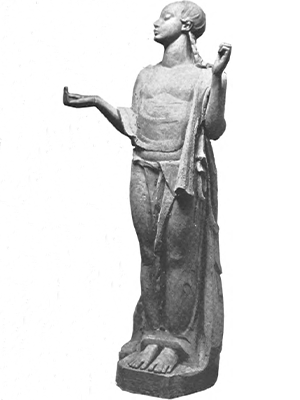
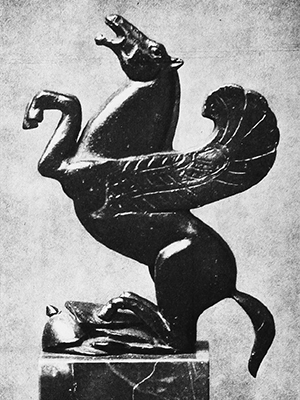
The following list documents some of Ripley’s exhibitions and prizes:
1905: Annual American Woman’s Art Association show – two small sculptures.
1919: The 28th annual Exhibition of the National Association of Women Painters and Sculptors – won the Helen Barnett prize for her sculpture “Inner Voice;” she also exhibited “Victory” (New York Herald Tribune, 1949, 20),
1919: Salon des Beaux Arts – "Seated Woman" (Lublin, May 20, 1919, 56).
1921: Milch Galleries – critics particularly praised "Inner Voice." Also shown were: “Seated Woman,” “Boy with Fish” (fountain sculpture), and “Pair of Garden Pots.”
1922: “Contemporary Women Painters and Sculptors” show in Paris – “Although the paintings which were shown were excellent, the sculpture attracted far greater attention, especially the works of Miss Malvina Hoffman, Miss Harriet Frishmuth, and Mrs. Lucy Perkins Ripley” (New York Herald European edition, June 4, 1922, 2).
1923: Art Institute of Chicago – “Paintings by Arthur Carles, Sculpture by Lucy Perkins Ripley and Alfeo Faggi”
1923: Grand Central Gallery – “Boy with Fish.” The show also included Janet Scudder’s “Victory.”
1925: Fifth annual exhibition of the Dallas Art Association at Stoneleigh Court.
1929: Fifty-Sixth Street Galleries in New York, a new gallery occupying an entire building at 6 56th Street – a small room was dedicated to her sculptures and drawings (Jewell 166).
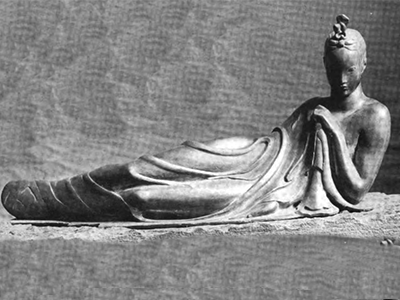
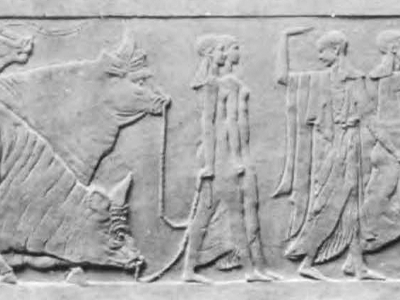
1934: Galerie de Paris, 17 ave. Victor Cousin, along with 34 painters and seven sculptors:
- A room is devoted to the African impressions of Lucy Perkins Ripley, a vigorous, artistic temperament, with a quick eye and facile brush (New York Herald European edition, Feb 21, 1934, 4).
- At the Galerie de Paris [...] Lucy Perkins Ripley has exhibited a number of paintings and drawings, which reveal talent and a sensitive personality (Chicago Tribune, March 5, 1934, 3).
- Lucy Perkins-Ripley: A varied exhibition. Lucy Perkins-Ripley is a painter and sculptor who is interested in the diverse, infinite problems of art with a fervent curiosity and a keen intelligence. Whether she is painting a still life laden with paste, concise compositions, noble figures that are dreamed more than observed, pungent interiors, sober landscapes, she is always free, spontaneous, witty, and lively. She treats each theme in a different spirit. She is never constrained by a particular style. Sometimes, she abandons herself to the prestige of light and color. At other times, she constructs figures with forms of a beautiful proportion. All in all, we must praise her: she paints with joy (translated from French, Beaux Arts, November 20, 1938, 8).
1935: La Nationale – a painting. “In her Study, Lucy Perkins-Ripley starts the same beautiful adventure once again. But does she know where she is going?" (translated from French, Comoedia 3).
1936: Georgette Passedoit Gallery in New York – paintings representing her 10 years abroad. “There is a certain elegance about her paintings, something utterly carefree and enjoyably feminine. They are also very French” (Burrows E10).
1936: Galerie de l’Elysée, 69 Faubourg St. Honoré – “Lucy Perkins-Ripley exhibits cursive watercolors where the line and color are spiritually juxtaposed, with plastic oppression stemming from Duffy, passing by Matisse” (translated from French, Semaine à Paris 45).
1936: Dallas Museum of Arts Centennial Exhibition of Paintings, Sculpture, Graphic Arts, June 6 – November 29 – “Brittany Girl.”
1939: Salon des Tuileries in the newly opened Palais de Chaillot, which housed an impressive 2,500 works of art.
Lucy Perkins Ripley died on September 8, 1949 at the age of 72.
Sources
- “À travers les galeries.” La semaine à Paris. November 27, 1936, p. 45. Gallica.
- Bulletin of the Department of Labor, U.S. Government Printing Office, vol. 9, no. 54-55, 1904, p.1606. Google Books.
- Burrows, Carlyle. “Notes and Comment on Events in Art.” New York Herald Tribune, April 5, 1936, p. E10. ProQuest Historical Newspapers.
- Catalog from the exhibition, “The Centennial Exhibition of Paintings, Sculpture, and Graphic Arts," June 6–November 29, 1936, held at the Dallas Museum of Fine Arts. Includes: artists and artworks in the exhibition, essays, and images. Texas history
- Dallas Museum of Art
- Devree, Howard, “Art Shows: Brief Comment on New Exhibitions.” The New York Times, April 12, 1936 p. X8. ProQuest Historical Newspapers.
- “41 Americans at Art Shows at Galerie de Paris.” New York Herald (European edition), February 21, 1934, p. 5. Gallica.
- Frelinghuysen, Alice Cooney, Martin Eidelberg, and Adrienne Spinozzi American Art Pottery: The Robert A. Ellison Jr. Collection, Metropolitan Museum of Art, 2008, p. 253. Google Books.
- “Gobelin Museum Stages Exhibition Showing Oriental Origins of Tapestry.” The Chicago Tribune and Daily News, New York, March 5, 1934, p. 3 Gallica.
- Hutchinson, Elizabeth. “Playing Indian: Native American Art and Modern Aesthetics.” The Indian Craze: Primitivism, Modernism, and Transculturation in American Art, 1890–1915, Duke University Press, 2009, pp. 91-129. Duke Press.
- “In the Realms of Art and Music: Grand Central Gallery Shows Donated Oils and Sculpture.” New-York Tribune, June 24, 1923, p. D10. ProQuest Historical Newspapers.
- Jewell, Edward Alden. “The New Museum of Modern Art Opens.” The New York Times, November 10, 1929, p. 166.
- Kostpoth, B.J. “American Artists Exhibit Works in Salon des Tuileries.” The Chicago Tribune and Daily News, New York, May 16, 1934, p. 3. Gallica.
- “La peinture à la Nationale.” Comoedia, April 30, 1935, p. 3. Gallica.
- “Les Expositions.” Beaux-Arts, November 20, 1936, p. 8. RetroNews.
- Lublin, C. Owen. “Arts and Decoration.” Town and Country, vol. 75, no. 3731, March 10, 1919, p. 44. ProQuest.
- Lublin, C. Owen. “Arts and Decoration.” Town and Country, vol. 76, no. 3738, May 20, 1919, p. 56. ProQuest.
- Merrick, Lula. “Lucy Perkins: Sculptor.” International Studio, vol. 75, no. 299. March 1922, pp. 14-18. Internet Archive.
- “Mrs. Lucy P. Ripley.” Obituary. The New York Times, September 8, 1949, p. 29.
- “Mrs. Lucy Perkins Ripley.” Obituary. New York Herald Tribune, September 9, 1949, p. 20. ProQuest Historical Newspapers.
- “News of Americans in Europe.” New York Herald Tribune (European edition), April 16, 1937, p. 4. Gallica.
- “News of Americans in Europe.” New York Herald Tribune (European edition), April 18, 1939, p. 4. Gallica.
- “Nouvelles expositions.” Les Échos de Paris, November 18, 1936, p. 5. RetroNews.
- Patterson, Augusta Owen. “The Decorative Arts.” Town & Country, vol. 81, no. 3944, September 15, 1926, pp. 56-57, 98. ProQuest.
- Patterson, Augusta Owen. “The Decorative Arts.” Town & Country vol. 82, no. 3959, May 1, 1927, p. 55. ProQuest.
- Price, Anita Davis and Jimmy S. Emerson. New Deal Art in Alabama, McFarland, 2015.
- “Recent American Sculpture in Bronze, Wood, and Terra Cota: For the Town and Country House, Grounds and Gardens.” Milch Galleries catalogue, May 3- May 22, 1919. Metropolitan Museum of Art Watson Library.
- Saint-Gaudens, Homer, The Reminiscences of Augustus Saint-Gaudens, The Century Co., 1913, p. xvi. Internet Archive.
- “Salon des Tuilleries Opens in the New Palais de Chaillot.” New York Herald Tribune, August 13, 1939, p. E5. ProQuest Historical Newspapers.
- Wisconsin alumnus, volume 69, number 6, March 1968.
- “Women as Sculptors. The New York Herald (European edition), June 4, 1922, p. 2. Gallica.